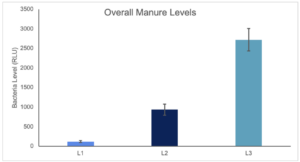Final report for GNE19-192
Project Information
Small-scale egg production is a growing industry in New England. However, foodborne illness risk exists from small-scale pastured eggs due to lack of guidelines for safe handling and management practices. We hypothesized that the manure level (ML) of the eggs along with management practices will affect both the total shell bacterial levels (measured in relative light units = RLU) and the cuticle deposition of the eggshell. Hens (n=53) were used in this study and housed on Peckham Farm at the University of Rhode Island; Kingston, RI in a mobile coop that allowed free ranging. The management practice experiments were divided into nest box type, location, substrate, and time/frequency of collection. The cuticle deposition experiments involved nesting boxes and nest substrate. Data were analyzed using SAS proc mixed/ANOVA tests (P ≤ 0.05). There is a difference in Manure Level between level 1 and 2 and level 1 and 3 eggs. Eggs collected from the conventional and rollaway nest boxes showed no difference in the bacteria levels (RLU) or cuticle deposition, but there was a significant difference in preference of where the hens laid eggs. Eggs collected from conventional nest boxes with different nesting substrates (straw, shavings, AstroTurf nest pad) showed no difference in bacteria levels (RLU) and cuticle deposition. Nest box location (mounted vs floor level) showed no difference in bacteria level RLU values from eggs collected from conventional nest boxes. Time of collection (1pm vs 8 am) had a significant impact on bacteria level RLU values however frequency of collection showed no impact. The bacteria levels were most likely lower in the afternoon collection because the eggs laid that day did not spend as much time in the nest boxes. In conclusion, although different nest boxes or substrates did not change eggshell bacteria levels, management practices that minimize manure levels on eggs and changing the time of collection can help to maintain lower bacteria levels to reduce food safety risk.
Objective 1A: Does nest box type (conventional wall-mounted vs roll-away) reduce dirt/ manure and bacteria on eggs? Eggs will be collected once daily (8am) first from both the conventional wall-mounted nest boxes and roll away boxes.
Objective 1B: Does frequency of egg collection (1 vs 2 times per day) reduce dirt/manure and bacteria levels? Eggs will be collected either once daily (8am) or (12pm) or twice daily (8AM and 12PM) from rollaway and conventional nest boxes.
Objective 1C: Does nest box (conventional) location (mounted 18” high or on ground ) reduce dirt/ manure and bacteria on eggs? Comparison of egg cleanliness and bacterial count on eggshell from eggs collected from the 10-hole nest box mounted at 18 inches in the coop vs eggs collected from nest boxes at the coop floor level. For this experiment only the conventional nest box will be tested- rollaway nest boxes removed from the coop.
Objective 1D: Does nest box material (plastic mat vs straw vs shavings) reduce dirt/manure and bacteria on eggs? Hay and shavings material will be placed in each of the mounted conventional nesting boxes. Plastic mats are commonly used in metal and roll away nest boxes to minimize manure contamination from organic nest box materials. Comparison will include straw (control) vs shavings, comparison of straw (control) vs plastic nest pad, rollaway week 1- plastic nest pad substrate and rollaway week 2- no substrate.
Objective 1E: Is there a preference for rollaway vs conventional mounted nest boxes and nesting material? During objective 1A and 1D data will be collected on preference of type of nest box and nesting material used in the boxes.
Objective 2: Comparison of cuticle on clean (no dirt/manure) washed and unwashed eggs.
There are no evidence-based guidelines on the proper management, washing, handling of eggs collected from pasture-raised small-scale poultry farms which could contribute to food safety risks for farmers and consumers involved in local food production. The purpose of this project is to identify the best management practices, including frequency of egg collection, type of nest box, location of nest box and nest materials, that will result in consistent cleanliness of eggs (no manure/dirt) with decreased bacterial load on the eggshell to develop safe handling guidelines for small-scale free-range poultry producers in the area. In this study, new information will be generated on best practices for management and egg handling for free-range hens to develop guidelines to support the sustainability of local egg production.
Cooperators
- (Educator and Researcher)
- (Researcher)
- (Researcher)
Research
This research was conducted on the University of Rhode Island’s Peckham Farm which houses the food animals used in teaching and research on campus. We are currently pasture-raising 53 laying hens (Barred Rock, Buff Orpington, Red sex-liked, RI Red, White Leghorn, Easter Egger) using a mobile chicken tractor.
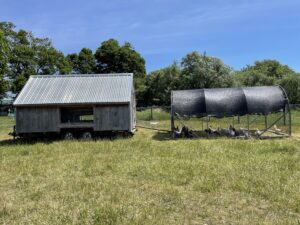
For each experiment, eggs were collected from the pasture-raised flock at the same time of day and bacterial sampling conducted within 3 hours of collection. The chicken tractor was moved daily to provide birds with fresh forage and the coop floor scraped every morning to ensure cleanliness of the inside of the coop. Nesting materials used in the conventional style boxes were straw and changed out weekly. Rollaway boxes were lined with the astroturf nest pads and cleaned weekly.
Objective 1A: Does nest box type (conventional wall-mounted vs roll-away) reduce dirt/ manure and bacteria on eggs? Eggs were collected once daily first from both the conventional wall-mounted nest boxes and roll away boxes. Both conventional and rollaway boxes were used simultaneously throughout this experiment, except for the last week of collection in August where only the rollaway was available to the hens. 12-15 eggs were collected on three separate days throughout each week. Data was collected from May 18th - August 25th. Both box types were mounted at 16-18 inches in the coop. Straw was used as the substrate in conventional boxes and astroturf nest pad in rollaway box and both were completely cleaned out once weekly. After eggs were collected daily at the same time (approx. 8am-9am), they were inspected for cleanliness level (Egg Dirt/Manure Chart below). Once the eggs have been inspected and ranked on cleanliness, a sample for total bacteria was taken with Microsnap test swabs.
Objective 1B: Does frequency of egg collection (1 vs 2 times per day) reduce dirt/manure and bacteria levels? Eggs were collected either once in the am (~8am), once in the afternoon (~1pm) or twice daily (8AM and 12PM) daily from rollaway and conventional nest boxes with 12 eggs collected per day for three consecutive days (36 eggs per treatment; 144 eggs total). This experiment was conducted between June 29th and July 16th. Straw substrate was used in conventional wall mounted and astroturf plastic mat in the rollaway nest boxes and the substrate was cleaned weekly. When eggs were collected daily, they were inspected for cleanliness level (Egg Dirt/Manure Chart below). Once the eggs have been inspected and ranked on cleanliness, a sample for total bacteria was taken with Microsnap test devices.
Objective 1C: Does nest box (conventional) location (mounted 18” high or on ground ) reduce dirt/ manure and bacteria on eggs? For each location, at least 12 eggs were collected on three separate days. The same flock was used (location of conventional next boxes moved after all eggs had been collected). When the eggs were collected daily, they were inspected for cleanliness level (Egg Dirt/Manure Chart below) then a sample for total bacteria was taken. Comparison of egg cleanliness and bacterial count on eggshell from eggs collected from the 10-hole nest box mounted at 18 inches in the coop vs eggs collected from nest boxes at the coop floor level. For this experiment only the conventional nest box was tested- rollaway nest boxes were removed from the coop prior to the beginning of this experiment. Week 1- Nest box mounted at 18 in on wall of coop. Week 2- Nest box at floor level (bottom row of conventional 10 hole and conventional 2 hole boxes mounted around floor level in back of coop.
Objective 1D: Does nest box material (plastic mat vs straw vs shavings) reduce dirt/manure and bacteria on eggs? Hay and shavings material were placed in each of the mounted conventional nesting boxes. Plastic mats are commonly used in metal and roll away nest boxes to minimize manure contamination from organic nest box materials. This comparison included straw (control) vs shavings, comparison of straw (control) vs plastic nest pad, rollaway week 1- plastic nest pad substrate and rollaway week 2- no substrate. The standard time of collection and cleaning schedule was the same as previous experiments. For each bedding type, 12-20 eggs were collected on three separate days (167 eggs total). When the eggs are collected daily, they were inspected for cleanliness level (Egg Dirt/Manure Chart below) then a sample for total bacteria was taken with Microsnap test devices.
Objective 1E: Is there a preference for rollaway vs conventional mounted nest boxes and nesting material? During objective 1A and 1D data was collected on preference of type of nest box and nesting material used in the boxes. The amount of eggs collected from each nesting box (either rollaway or conventional) was recorded each day. This data will be used to determine if there is a preference in the nest box based on use by the chickens. Number of eggs collected from each nest box (conventional only) with different nest substrates will be recorded and used to determine if there is a trend in which substrate material (straw/shaving/AstroTurf mat) is most desirable for the hen while laying.
Objective 2: Comparison of cuticle egg parameters on clean (no dirt/manure) washed and unwashed eggs and eggs collected from different nest box types and nesting materials. Six eggs were collected in level 1-2 range on the Manure Level Chart periodically between August 6th and September 18th. Three of the eggs were washed according to the URI egg washing protocol (water at 100-105 F for 10 minutes with Egg Wash Powder, rinse) in Incredible Egg Washer ™) and the other 3 eggs left unwashed. After the washed eggs were done drying, three equidistant measurements were taken along the eggs equator with the Minolta Colorimeter. The eggs were then dyed according to the Sartini Cuticle Deposition protocol and three more equidistant measurements were taken along the eggs equator after eggs were dyed. An equation (provided by Dr. Ian Dunn) was used to calculate the Delta E value of each egg. This number was able to show the change in cuticle thickness on the eggshell between the washed and unwashed eggs. Six to eight eggs were collected from either the rollaway or conventional nest boxes and different nesting substrates (straw, shavings, Astroturf nest pad) periodically from August 6th-September 18th. These eggs were measured and stained according to the Sartini Cuticle Deposition protocol.
All data collection for objectives 1a-1e were completed during the peak laying period (25-40 weeks), which is between the dates of May 8th- August 27th. The coop floor was scraped daily every morning and the nest box substrate cleaned out weekly and replaced.
Bacteria level quantification: Egg bacterial levels were measured using the Hygiena Microsnap testing swabs (Hygiena, LLC, Camarillo, CA) which is measured in Relative Light Units (RLU).
Nest Box Type Experiment:
Egg shell total bacterial levels were not different between the conventional (n = 37) and rollaway (n = 25) nest box types (p = 0.85). There was a significant preference for the conventional style nest boxes for laying over the rollway nest boxes (p< .0001).
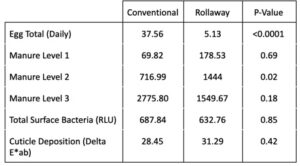
Nesting Material Experiment:
When comparing straw, shavings, and Astroturf nest pad nesting materials (n = 179), no difference was found in shell bacteria levels (RLU;p = 0.29).
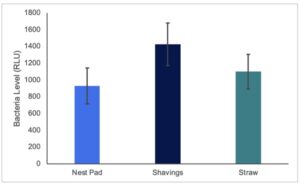
Time and Frequency of Collection Experiment:
There was a difference in shell total bacteria levels (RLU; p = 0.02) in the time that eggs were collected daily (1x daily at 1pm showed a difference in shell bacteria levels (RLU) when compared to eggs collected at 8am 1x per day) but no difference (p= 0.49) if eggs were collected more frequently (2X per day vs 1X per day) eggs were collected (1x vs 2x day) on RLU levels.
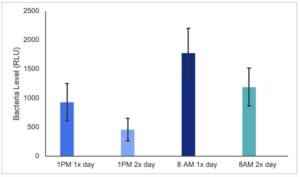
Nest Box Location Experiment:
There was no difference (p= 0.65) in shell bacteria levels (RLU) on eggs laid in wall mounted nest boxes compared to eggs laid in floor level nest boxes.
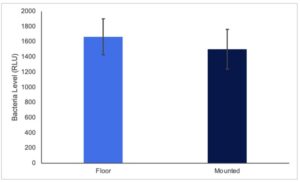
Manure Levels:
There is a correlation between visible manure contamination and shell total bacteria levels (ML Chart; Table 1).. On eggs collected from conventional nest boxes with straw substrate or rollaway nest boxes with Astroturf nest pads (collection 1x daily at 8 am), a significant difference (p < .0001) was found between the overall manure levels (ML). Level 1 and 2 and level 1 and 3 showed the most significant difference overall (p< .0001). ML 2 and 3 showed no difference (p= 0.2). The difference in ML 1 and 2 and level 1 and 3 can be directly correlated to the visible amount of manure contamination on the eggshells. . Even though level 3 eggs were visibly “dirtier”, the bacteria levels between levels 2 and 3 were similar.
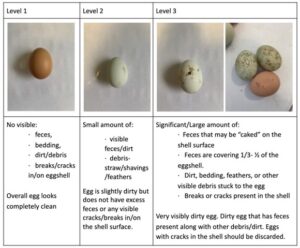
When comparing nest box type, there were no differences in ML 1 and 3 in conventional and rollaway boxes (p ≥ 0.18). There was a difference (p= 0.02) in ML 2 when comparing conventional and rollaway nest boxes. Manure contamination for eggs considered level 1 and 3 were consistent between the two nest box types, signifying that those levels will always fall in a certain RLU range. The level 2 eggs showed a difference which can be attributed to the difference in manure contamination between the different nest box types.
Cuticle Deposition:
The cuticle thickness was not different on eggs collected from rollaway or conventional nest boxes (p= 0.42) or on eggs collected from conventional nest boxes with different nesting substrates (straw, shavings, nest pad; p= 0.28). It was hypothesized that there may be a difference in cuticle deposition in eggs collected from conventional vs rollaway nest boxes because in the conventional boxes the hens could continually step/sit on the eggs until they were collected. In this case, the ability for the hens to continually step/sit on already laid eggs showed no difference in the thickness of the cuticle when compared to eggs that could roll into a compartment away from the hen after being laid. Regardless of the substrate used, the cuticle stays intact on the egg comparatively between straw, shavings, and Astroturf nest pad.
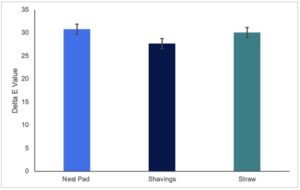
Based on these results, a variety of nest box types, nesting materials, and nest box locations can be used without changes to shell bacteria levels or the cuticle thickness. To minimize total surface bacterial levels, eggs should be collected in the afternoon once daily compared to an early morning collection time. Eggs kept at a manure level 1 will have reduced shell bacteria levels when compared to eggs at manure levels 2 and 3.
Education & Outreach Activities and Participation Summary
Participation Summary:
During the course of this research I created the Manure Level Chart to sort the eggs collected by the visual cleanliness of the eggs. This will be used in the. future for educational purposes with local poultry farmers based on the bacteria level range for each Manure Level of the eggs. This chart will help guide producers on which eggs may/may not need to be washed or if different washing methods are acceptable. It also gives a visual example of the shell bacteria levels of eggs in each manure level.
This July 2021 I also presented a poster at the American Society of Animal Science annual conference. This gave me the opportunity to present this research and conclusions to other researchers and graduate students across the country. Unfortunately due to the Covid-19 pandemic the Livestock Institute conference was not held and the Rhode Island Food Summit was held virtually so I was unable to present my research and findings to local producers in the Rhode Island area.
I am also in the process of editing a manuscript to be submitted to the Journal of Applied Poultry Research.
This research helped supply preliminary data to fund a NIFA grant which will have a more comprehensive outreach and educational program.
Project Outcomes
This project will help contribute to future sustainability by improving food safety for shelled eggs on smaller scale farms along with proper and efficient management of laying hens. While investigating the management practices for free-range laying hens, I found that nest box type (rollaway vs conventional), nesting materials, and nest box location did not have an effect on shell bacteria levels. Time and frequency of collection did have an effect on the bacteria levels of the eggs. Eggs collected in the afternoon one time per day showed overall lower shell bacteria levels than eggs collected in the morning one time per day. Frequency of collection did not show a significant difference but collecting 2x a day showed a tendency for lower shell bacteria levels when compared to collecting 1x day in the morning.
There is a correlation between visible manure contamination and shell total bacteria levels (Manure Level Chart). On eggs collected from conventional nest boxes with straw substrate or rollaway nest boxes with Astroturf nest pads (collection 1x daily at 8 am), a significant difference was found between the overall manure levels (ML). Level 1 and 2 and level 1 and 3 showed the most difference overall. ML 2 and 3 showed no difference. The difference in ML 1 and 2 and level 1 and 3 can be directly correlated to the visible amount of manure contamination on the eggshells. Even though level 3 eggs were visibly “dirtier”, the bacteria levels between levels 2 and 3 were similar.
The cuticle thickness was not different on eggs collected from rollaway or conventional nest boxes or on eggs collected from conventional nest boxes with different nesting substrates (straw, shavings, nest pad). It was hypothesized that there may be a difference in cuticle deposition in eggs collected from conventional vs rollaway nest boxes because in the conventional boxes the hens could continually step/sit on the eggs until they were collected. In this case, the ability for the hens to continually step/sit on already laid eggs showed no difference in the thickness of the cuticle when compared to eggs that could roll into a compartment away from the hen after being laid. Regardless of the substrate used, the cuticle stays intact on the egg comparatively between straw, shavings, and Astroturf nest pad. Washed eggs (Incredible Egg Washer ™) did show a difference in cuticle coverage of the egg when compared to unwashed eggs.
The lack of difference between bacteria levels and cuticle integrity in nest box type and nesting materials leaves farmers with flexibility in purchasing and preference for management that will not impact food safety risk.
This project has helped to fund another project that was built on the research and justification from this SARE grant. The Sartini Lab has received funding from a NIFA grant for the project titled, "Developing Evidence Based Handling Guidelines for Improving the Safety of Free-Range Poultry Eggs". Receiving this funding has led me to leveling up from a Masters to PhD student and continuing my studies in supporting small-scale poultry farmers to increase the availability and safety of local foods. The summary and aims of this project are as follows:
We propose to conduct pilot studies to develop evidence-based and cost-effective egg handling guidelines and educational materials for small-scale egg producers in our region.
The aims of this proposal are:
1) Determine the prevalence of Salmonella in chicken eggs from small-scale farms in Rhode Island and Connecticut.
2) Determine the efficacy of common egg washing methods to reduce total bacterial load and Salmonella on eggs and
3) Develop outreach and educational programs to train the farmers in proper egg handling and food safety and disseminate results of the research.
